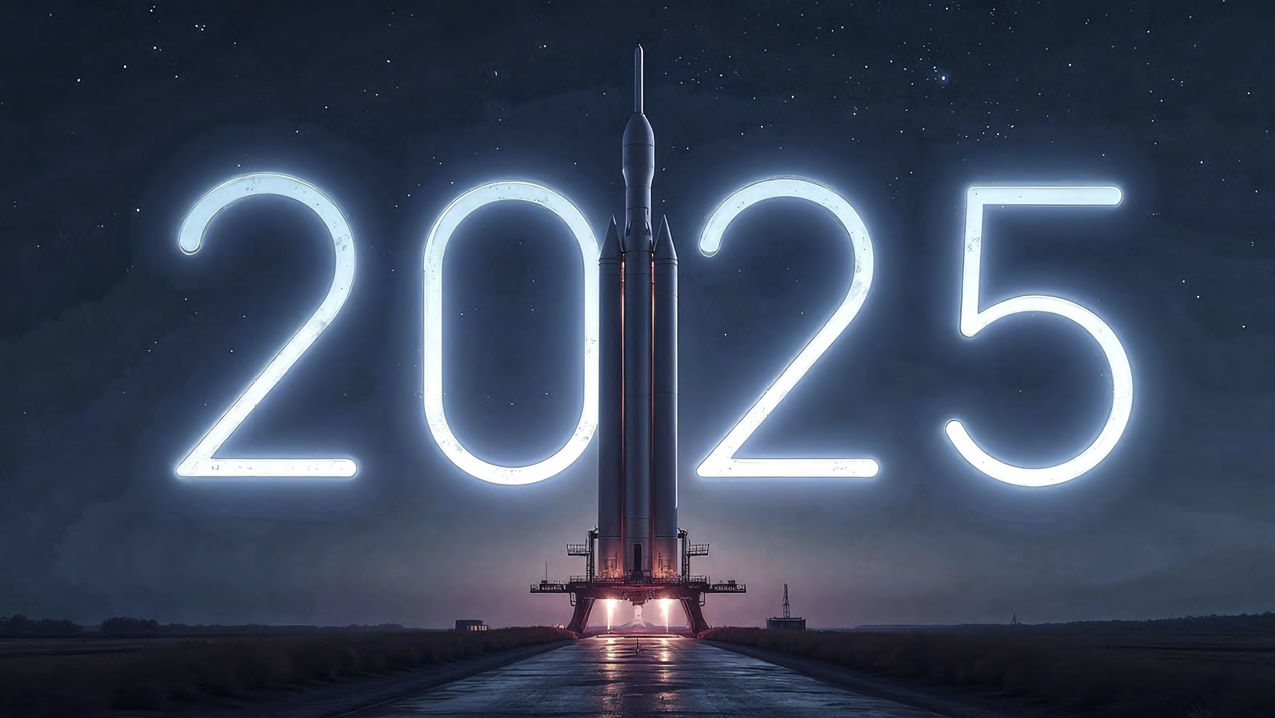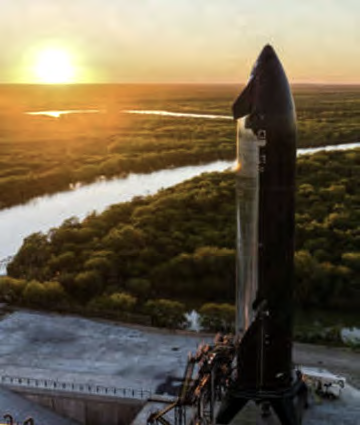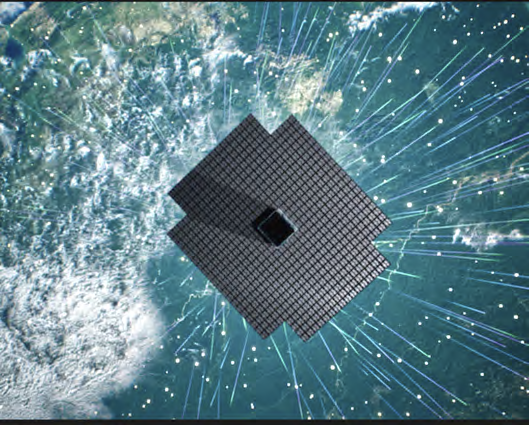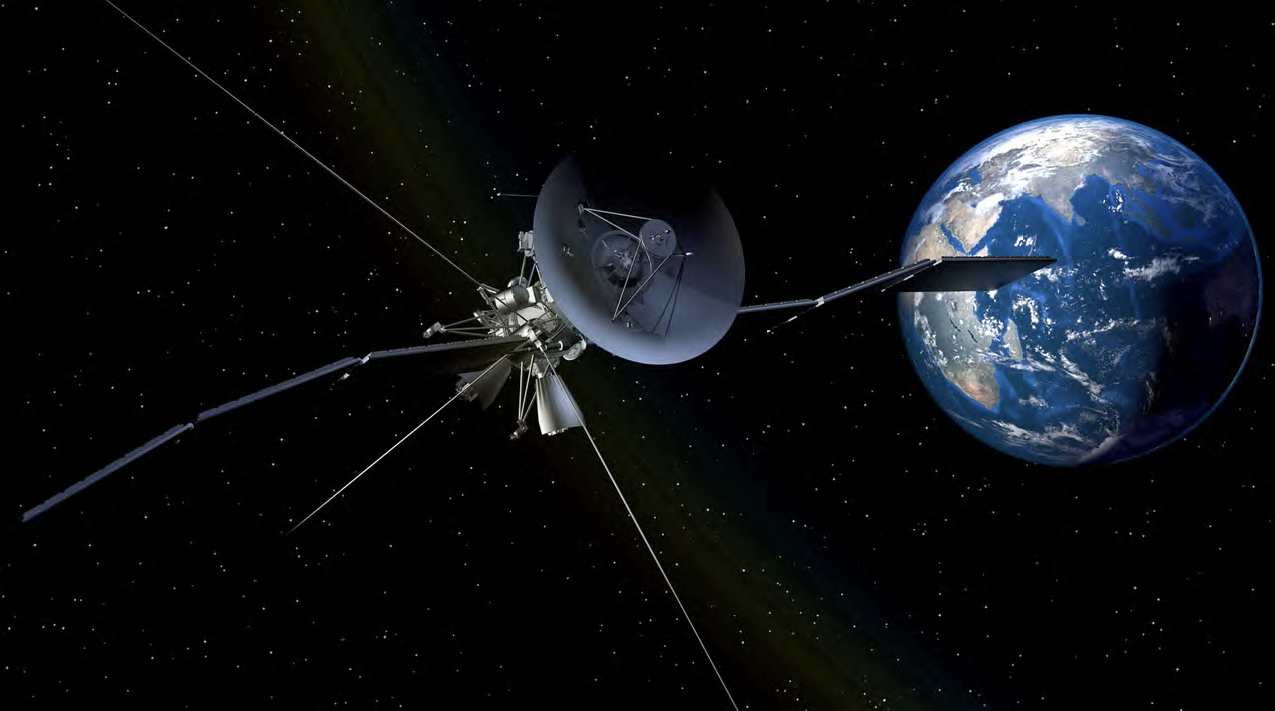Chris Forrester, Senior Columnist, SatNews Publishers
The New Year is looking good. There are dozens of reasons to be optimistic about the space and satellite industries.
2024 witnessed progress being made with SpaceX’s Starship and Starlink, while AST SpaceMobile (AST) also achieved—with SpaceX’s help—the launch of their five BlueBird satellites. Later in 2025, subject to the usual clearances, we’ll see the combination of SES and Intelsat and, in the process, create an operational behemoth with, perhaps, these companies and the industry ready to grow and expand.

The world’s airline passengers will increasingly enjoy in-flight WiFi. Indeed, Air Canada announced in December that—with Intelsat—it would provide ‘free’ WiFi on its flights. Starlink is contracted by United, Air France and Qatar Airways.
Additional operators claiming significant aircraft WiFi ‘wins’ last year include Viasat/Inmarsat, EchoStar/Hughes and Intelsat, while Panasonic and Thales have considerable activity in the air (as does Gogo with its business aviation division). Jeff Bezos’ Project Kuiper is also seeking a seat or two on this in-flight connectivity (IFC) ride.

SpaceX Starship
In December of last year, SpaceX completed its first Direct-To-Cellular (D2C) fleet of 330 satellites, as well as wrapping up more than 80 Starlink missions during 2024. Now, Elon Musk’s ambitions are to start launching his Starships at pace—there’s even talk of 25 launches during 2025.
SpaceX during 2024 also expanded the Starlink constellation to around 6,800 satellites, according to satellite tracker and astrophysicist, Jonathan McDowell.
Moreover, SpaceX continued filling the gaps in its licensed coverage notably for some African nations and over the Asia-Pacific (APAC) regions. Headlines were made in December with the news that SpaceX’s Tender Offer of $1.25 billion of new shares and that they were priced at $185 per share, thereby valuing the rocket-to-broadband company at about $350 billion.

AST Bluebird
___________
2024 on ‘X’
___________
The share price of $185 is well ahead from the $112 set in a prior valuation less than three months ago, said the memo to potential buyers. SpaceX itself is offering to purchase as much as $500 million worth of common stock, it says. Sources add that demand for shares was “overwhelming.”
Meanwhile, the day-to-day expansion of Starlink markets continues. Starlink’s high-speed internet is now available in Timor-Leste, marking the 116th country, territory or market around the world where service is available and is steadily expanding its broadband service.

SpaceX Director of Enterprise Sales, Andrew Matlock, outlined the company’s ambitious plans to expand its Starlink satellite internet service to Papua New Guinea while speaking at the PNG Resource Week in Sydney, Australia, just before the holidays.
AST was also busy, not the least of which was in firmly adding Vodafone to its contracted roster of telcos. Vodafone, and its own partner telcos, can offer AST’s space-based cellular broadband connectivity in its home markets and for its partner operators in Europe, Africa and parts of Asia. It operates in more than 20 markets under its own name and its partnerships operate in more than 40 additional locales.
The deal is said to be potentially more valuable than the Verizon agreement, although financial terms were not revealed in AST’s December 9 announcement. As well as Verizon, AST also has AT&T firmly in its grasp, and Vodafone is by any measure, a valuable additional retailer for AST. Vodafone has been a financial investor in AST since 2018 and had an initial $25 million initial investment in the satellite company.
Looking Forward to Some 2025 Highlights
25+ Starship launches (if FAA approves)
• Easily 125+ Falcon 9 flights
• Blue Origin’s New Glenn debut & growth
• Stoke Space’s Nova rocket debut
• Rocket Lab’s Neutron rocket debut
• SES-Intelsat consolidation
• Additional landing rights for OneWeb
In April of 2023, AST and its partners completed the first-ever, space-based, voice call to an unmodified phone. That was followed by the first-ever, 4G download speed above 10 Mbps in June of 2023 as well as the first-ever 5G voice call in September of that year. Ultimately, the company and its partners have demonstrated more than 20 MBs/s download speeds to unmodified phones on a 5 MHz channel.
A Vodafone executive stated that the deal was a “landmark agreement” and would deliver cellular connections directly in Vodafone’s mission to provide space-based broadband connectivity directly to their customer’s and everyday cell phones. The agreement will eliminate “dead zones” and bring “true global connectivity to live and enhancing seamless and reliable service across the Vodafone footprint.”
AST SpaceMobile has also notified the Federal Communications Commission (FCC) that all five of its Block-1 BlueBird satellites have been successfully deployed into their orbits, consistent with conditions set forth in the FCC authorizations.
The task for AST is to now rapidly expand its existing fleet in order to achieve the company’s global ambitions. It is looking to have more than 60 satellites on-orbit by the close of 2025 and thus begin its global coverage. Reach of these new satellites measure some 225 sq. meters in area, significantly larger than the existing, first-generation craft that measure 65 sq. meters.
The company has agreements with more than 45 Mobile Network Operators (MNOs) across the globe, which have over (approximately) 2.8 billion existing subscribers in total. The MNOs include Vodafone Group, AT&T, Verizon, Rakuten Mobile, Bell Canada, Orange, Telefonica, TIM, Saudi Telecom Company, Zain KSA, Etisalat, Indosat Ooredoo Hutchison, Telkomsel, Smart Communications, Globe Telecom, Millicom, Smartfren, Telecom Argentina, MTN, Telstra, Africell, Liberty Latin America and others.
AT&T, Verizon, Vodafone, Google, Rakuten, American Tower, Cisneros Group and Bell Canada are also existing investors in AST.
Vodafone is a leading European and African telecoms company. “We provide mobile and fixed services to over 330 million customers in 15 countries, partner with mobile networks in 45 more and have one of the world’s largest IoT platforms. In Africa, our financial technology businesses serve almost 83 million customers across seven countries – managing more transactions than any other provider,” the company said.
Just before the holiday, AT&T outlined how it wants to serve its subscribers when the user is in a ‘not spot’ and will use AST to cover most of the U.S. (northern Alaska might be a challenge) with AST’s satellite coverage.
AT&T CEO, John Stankey, explained his forward-looking strategy and how AST would evolve from its current 5 orbital satellites over the next few years until 2029, when the satellite constellation would be more, or less, complete.
Stankey said, “You’ll see us plug their services in the edges we don’t cover, over the ocean, in the Grand Canyon, or in places it doesn’t pay for us to put up a cell tower to cover that footprint.”
AST is currently building two of its BlueBird Block 2 satellites every month and is boosting that output and it has been suggested that by the end of 2025, they could have around 90 satellites on-orbit. AT&T said they would need 95 AST craft on-orbit in order to supply “a near-continuous” service.
One analyst asked Stankey, “Why not get a consortium together, spend a few billions and build a LEO constellation [yourself]?” Stankey replied, “AST SpaceMobile has already done it.”
Some of AT&T’s comments...
“Our strategy with satellite is that it will augment terrestrial services when it comes to telephony.”
“We’ve been involved in satellites with AST since the very beginning with the first one in orbit.”
“We understand the capacity each of these birds is limited to, the amount that we can task up for broadband applications can serve up a number of customers.”
“We’ve chosen the path for it to be complimentary to the products and service that we offer to our biz and consumer customers.”
“Rather than having satellite dedicated spectrum, lifting up spectrum that’s already embedded in the handsets (direct-to-device) is important in order to make that strategy effective, you need a fleet of satellites that are engineered to have that kind of RF gain, the antenna array of those satellites need to be strong and large enough to ensure the level of service of those handsets is equal as best as possible from what the consumer expects from a cell site on the ground.”
“That’s why we’ve partnered and invested in AST to get their technology lifted up into orbit.”
However, while praise is justifiably due for AT&T’s enthusiasm, there was no mention from AT&T of SpaceX’s Starlink which is already supplying Text and SMS services to some markets.
The prize, according to data from Novaspace/Euroconsult, is a D2D satellite business worth $42 billion by 2033 in service revenues. The researchers latest report shows strong growth in direct-to-phone services and IoT applications, highlighting the impact of satellite networks on global connectivity.
AST and Starlink are not alone. GlobalStar/Apple must not be ignored, or Lynk, or Jeff Bezos, or Rivada. All have their eyes on—at least—segments of the D2D demand.
GlobalStar’s ‘Applestar’ will offer voice, data in 2025 at 5G speeds, said the company. An Investors Day held by GlobalStar on December 11th. placed considerable emphasis on its Band n53 spectrum of 2.4 GHz, and tests conducted using XCOM RAN prototype radios and 5G modules, which validated the utility of the Band n53 spectrum for even the most cutting-edge mobile applications and builds on the success from the 4G testing announced in October of 2024 at Mobile World Congress Las Vegas. One observer stated that Starlink is “ten times slower” than GlobalStar. Apple owns 85% of GlobalStar.
In Europe, there was also considerable progress. SES uses SpaceX to launch two additional O3b/mPOWER satellites to its existing fleet. Both satellites feature redesigned payload power modules from Boeing and will join the first six O3b mPOWER satellites already in operation at Medium Earth Orbit (MEO).
The two additional satellites will bolster the second-generation MEO system to continue delivering high-quality connectivity services. The two craft arrived at Cape Canaveral for their launch on December 3rd.
SES has been deploying O3b mPOWER services worldwide since April of 2024, with the system’s core infrastructure deployed, tested and in use on a global basis.
Meanwhile, SES has won a ‘Blanket Purchase Agreement’ contract from the U.S. Department of Defense (DoD) with a potential value of $117 million for the operator’s “multi-orbit, multi-band satellite capabilities.”
There’s one other player still talking about an initial 300 satellite constellation: Rivada Space Networks. Their senior staff are talking—perhaps optimistically—about still making their International Telegraph Union (ITU) obligations of having 50% of the constellation on-orbit by June 2026.
For that to occur, they have to stump up some $2.4 billion in order for Lockheed Martin/Terran Orbital to start the build of Rivada’s highly secure OuterNET system. Or perhaps they will be looking for an extension permit from the ITU?
One industry observer has suggested that 2025 will be “the Golden Age’” for the space industry. That is a sentiment that we can all endorse.

Chris Forrester
Author Chris Forrester is the Senior Columnist and Contributor for SatNews Publishers and is a well-known broadcasting journalist and industry consultant. He reports on all aspects of broadcasting with special emphasis on content, the business of television and emerging applications.

